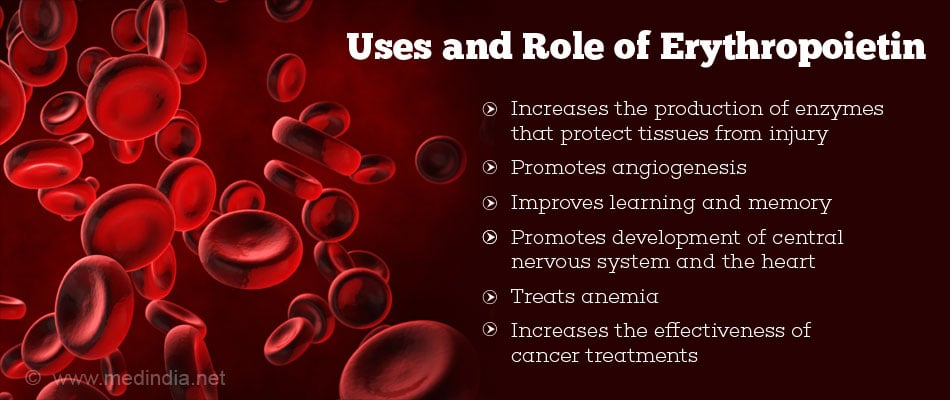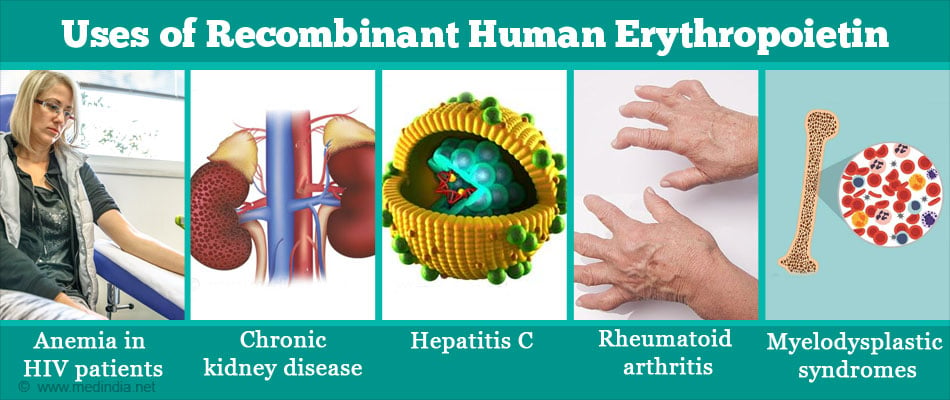- The Story of Erythropoietin - (http://www.hematology.org/about/history/50-years/1532.aspx)
- EPO Erythropoietin - (https://www.ncbi.nlm.nih.gov/gene/2056)
- Pure Red Cell Aplasia (PRCA) - (http://www.aamds.org/diseases/related/pure-red-cell-aplasia-prca)
What is Erythropoietin?
Erythropoietin (EPO) is a hormone predominantly produced in the kidney, which is then released into blood. Erythropoietin promotes the production of red blood cells (erythropoiesis) in the bone marrow by binding the erythropoietin receptor EPOR.
Erythropoietin is used as replacement therapy in patients deficient in EPO as may occur in chronic kidney disease. Besides erythropoiesis, EPO has been shown to be involved in other functions as it is found in different tissues of the body.
Brief History of Erythropoietin
- In the early 20th century (1906), French scientists Carnot and DeFlandre hypothesized (from their experiments) the presence of a factor that controlled the production of red blood cells. They named this factor hémopoïétin.
- In the decades of the 50s and 60s, it was conclusively established that low oxygen in the body, as seen in anemic patients, resulted in the production of erythropoietin by the kidneys, which in turn stimulated the production of red blood cells.
- In 1977, endogenous EPO hormone was isolated from the human body
- In 1985, the EPO gene was cloned.
- The synthetic form of the EPO hormone was generated and tested on anemic patients with kidney failure in 1983.
- In June 1989, EPO was approved by FDA to treat anemia in chronic kidney disease (CKD).
How is Erythropoietin Produced?
Erythropoietin is largely produced in the kidneys but is also found in liver, eyes, gut, muscle (smooth, heart, skeletal), uterus, testes, spleen, lungs, pancreas, and brain.
The gene EPO for erythropoietin stimulating its secretion is expressed due to 3 reasons:
- When the oxygen pressure in the arteries decreases
- In the presence of low oxygen or hypoxia in the body
- When the affinity of blood vessels for oxygen increases
Erythropoietin produced under such conditions, stimulates the production of red blood cells in the marrow and initiates hemoglobin synthesis, the pigment found in red cells that increases the oxygen-carrying capacity in the blood.
How Does EPO Work in the Body?
In the presence of low blood oxygen levels, specific proteins (hypoxia-inducible transcription factors - HIF) activate the production of erythropoietin. Activated EPO binds to related receptors (EPOR) on the surface of cells such as erythroid precursor cells in the bone marrow and initiates a biochemical reaction within the cells that stimulates the synthesis of red blood cells (erythropoiesis).
Many other cells display EPOR and hence, it is now known that EPO plays a role in other cells and displays other functions besides erythropoiesis.
What are the Uses and Role of Erythropoietin?
One thing is clear - erythropoietin is multifunctional in its action. Besides erythropoiesis, erythropoietin has been found to perform a wide variety of functions including:
- EPO increases the production of enzymes that protect tissues from injury due to free oxygen radicals.
- Increased blood vessel production (angiogenesis) is promoted by erythropoietin – for example, increased angiogenesis in the pancreas protects against type 1 or type 2 diabetes.
- Improves learning and memory
- Promotes development of central nervous system and the heart
- Promotes tumor development due to increased angiogenesis
- EPO exhibits protective effects in the brain (neuroprotective)
- EPO increases the effectiveness of cancer treatments
- EPO is used to treat anemia by stimulating erythropoiesis

Recombinant human erythropoietin (rhEPO) - Erythropoiesis-Stimulating Agents
There are different forms of recombinant human erythropoietin, viz. EPO-alpha, EPO-beta, Darbepoetin alpha, continuous erythropoietin receptor activator(CERA). Darbepoetin and CERA have longer half-life periods, and so they can be administered either once a week, once in 2 weeks, or once a month.
Recombinant human EPO is used to treat the following conditions:
- Anemia in HIV patients,
- Anemia due to chronic kidney disease (CKD),
- Patients with hepatitis C under treatment with ribavirin,
- Anemia of chronic disease (e.g. rheumatoid arthritis),
- Cancer and chemotherapy associated anemia
- Myelodysplastic syndromes
- To minimize the need for blood transfusions in critically ill patients, following surgery and anemia of prematurity
Epoetin alpha or Epo has been in use for the past 24 years to treat anemia (reduced blood cells) in the body.

Side-effects of rhEPO
Some of the side effects associated with rhEPO therapy include the following:
- Increased risk of thrombosis
- Symptoms of flu
- Potential tumor progression
- Allergic reactions
- Pure red cell aplasia
- Rare instance of seizures
- Diarrhea
- Shortness of breath
- Redness pain bruising and swelling at injection site
- Rise in blood pressure which needs to be monitored regularly
Resistance to rhEPO treatment
Some patients develop resistance to rhEPO treatment due to:
- Iron deficiency
- Overload of aluminium
- Hyperparathyroidism
- Inflammatory infectious disease
Resistance to rhEPO treatment is measured as hemoglobin count < 10g/l following 4 weeks of treatment
Abuse of rhEPO Treatment
When a patient is treated with rhEPO, it increases the body’s capacity to utilize oxygen. This helps in improving the fitness and endurance of individuals. In the sports arena, increased fitness and endurance are vital to athletes. Hence, this has led to the misuse of rhEPO. The International Olympic Committee banned sportspersons from using EPO in 1990.
Health Tips
In order to maintain optimum results from rhEPO treatment, the patient’s iron levels need to be continuously measured and if required, iron should be administered intermittently.
Consume a diet rich in iron containing foods such as greens, meats, eggs, cereals and vegetables.







